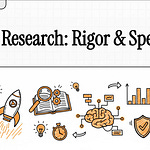You’re working on a project, tight deadline, tons of deliverables, and you think, “Why not let ChatGPT handle the first draft?” Then it hits you—am I cheating?
Spoiler: You’re not.
AI isn’t your replacement; it’s your boost. It’s the “intern” you wish you had on hand, ready to spitball ideas, summarize research, or save hours on repetitive tasks. But let’s not pretend it’s all smooth sailing. Questions like, “Am I doing this right?” or “Am I losing my edge?” creep in.
Today, we’re tackling this head-on. How can you leverage AI tools without losing your creativity, your credibility, or your voice? Let’s dive in.
Today’s Highlights
Key Insight: Embracing AI Without the Guilt
Why AI Won’t Steal Your Job
How to Stay Authentic While Using AI
Market Insights
How to use AI without feeling like a fraud
Things to keep in mind when using AI
Community Spotlight: What’s Your Favorite AI Hack?
Webinar: Craft case studies that gets you hired
Resource Corner: Books, Tools, and Insights for AI-Powered UX
Tool of the Week: Research Co-pilot
Key Insight: Embracing AI Without the Guilt
First things first: AI isn’t stealing your job. It’s here to make you faster, sharper, and more focused on what actually matters. It’s like having an assistant who never sleeps. But like any tool, it’s all about how you use it.
Why AI Won’t Steal Your Job
Sure, AI can generate wireframes or spit out user personas in seconds. But it can’t empathize, interpret user feedback, or connect the dots between business goals and user needs. That’s where you come in.
A Forrester report found that companies using AI in design processes increased efficiency by 30%, but only 18% said AI could match human creativity. (BotMemo)
AI can handle the heavy lifting, but the heart of UX—understanding people—still belongs to you.
How to Stay Authentic While Using AI
Think of AI as Your Assistant, Not Your Voice
AI can draft ideas, but your expertise refines them. Use it to sketch, brainstorm, or summarize, but never let it speak for you entirely.Validate AI Outputs with Real Data
Whether it’s generating user flows or suggesting layouts, test those ideas against real-world feedback. Let data guide the tweaks.Own the Process
Be transparent with your team or clients about when and how you’re using AI. It shows you’re embracing innovation while keeping the human touch.
Market Insights: AI is Becoming UX’s Best Friend
Usage on the Rise
Over 65% of UX professionals now use AI tools in their workflow, especially for research analysis and generating design drafts (Source).AI Cuts Costs, Not Corners
Companies report saving 15–20% on UX project costs by automating repetitive tasks. (BotMemo)Future Growth
By 2032, the global market for generative AI in design is projected to reach $7.75 billion, reflecting its growing importance (Source).
How to use AI without feeling like a fraud
Do we let AI amplify our creativity, or are we cheating the essence of originality?
AI raises questions. If you use it, are you cutting corners? Are you trading authenticity for efficiency?
Here’s the truth: AI is a tool, not a shortcut to creativity. It doesn’t replace your vision; it sharpens it. You’re still the driver—AI just helps smooth the road.
So, is using AI selling out? No. It’s how you use it that matters. Shape it, don’t let it shape you.
Things to keep in mind when using AI
Start with Your Ideas, Not AI’s Prompts
AI works best when it enhances your thoughts, not replaces them. Use it to brainstorm, refine, or test ideas—but don’t let it dictate the direction.Set Boundaries
Decide what’s sacred in your creative process. Maybe AI helps with routine tasks, but the final touches? All you.Use AI to Elevate, Not Replace
Let AI handle repetitive stuff—scheduling, formatting, or even generating rough drafts. You’ll have more time to focus on your unique perspective and craft.Review and Add Your Signature
AI can help create, but your voice is the magic ingredient. Always tweak, polish, and add your personality.Be Transparent
Embrace the fact you’re using AI—it’s a tool, not a crutch. Transparency builds trust and showcases your smart, efficient process
This week’s question: What’s advice would you give to people leveraging AI in UX?
This Week’s Answer:
Don’t just use AI—collaborate with it. AI is a powerful tool for generating insights, automating tasks, and speeding up workflows, but it’s your expertise that turns those outputs into meaningful user experiences. Use AI to explore ideas and uncover patterns, then refine them based on real user data and feedback.
Remember, AI can’t replace the human touch. It doesn’t feel empathy, understand context, or anticipate subtle user behaviors. That’s where you come in. Stay user-focused and critical of AI outputs. Always ask, “Does this truly solve the problem?”
Have a burning UX question? Share it HERE!, and we might answer it in our next issue.
2 DAYS TO GO — Upcoming workshop:
Join us to finally create UX case studies that truly stand out.
Too often, Uxers struggle to showcase their full potential because their case studies focus on the what instead of the why. Deliverables without context, decisions without explanation, and stories without impact—it’s the difference between landing your dream job and getting overlooked.
In just one session, you’ll gain the skills and confidence to create case studies that stand out in any portfolio review or interview.
Resource Corner: Tools and Reads for AI-Powered UX
Book: AI for UX Designers by Lise Pilot – A guide to using AI without losing your creative edge.
Tool: Stark – Make your designs more accessible with AI-driven contrast and color checks.
Tool of the Week: Research Co-pilot
Research Co-pilot is your go-to AI-powered assistant, designed to support and enhance every aspect of your UX journey.
Here’s how Research Co-pilot can supercharge your workflow:
Craft effective questions: Generate user interview questions that drive meaningful insights.
Remove bias: Detect and refine problematic wording for unbiased research.
Pilot test with ease: Simulate interviews to assess question clarity and relevance.
Streamline analysis: Organize and summarize responses to save time on synthesis.
… and a host of other tailored features to make your research smarter, faster, and more impactful.
You’re Not a Fraud, You’re Evolving
Using AI doesn’t make you less of a Uxer—it makes you adaptable. It’s not about shortcuts; it’s about working smarter and pushing boundaries. The future of UX is human-led, AI-assisted, and infinitely creative.















